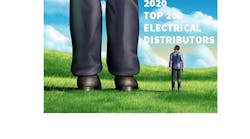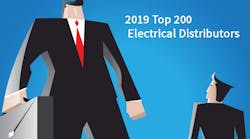With strong commercial construction and a solid multi-family market, the Dallas-Fort Worth metropolitan area is more than holding its own in a tough economic climate. Some industry folks in Dallas say strong population growth is fueling commercial construction.
“I think Dallas has continued to grow because we have a big influx of people,” says Dan McLaughlin, Dallas branch manager, Summit Electric Supply, Albuquerque. “Depending on who you talk to, we're the fourth largest metro, or we are going to be the fourth largest metro area in the United States by 2010. There are a lot of people moving here. We're still adding jobs.”
Dallas-Fort Worth is the fastest-growing U.S. metro area and the fourth-largest, with more than 6 million residents. The area added more people in 2006-07 than any other metropolitan area in the country, according to U.S. Census Bureau statistics. The figures show that the Dallas-Fort Worth metro area increased by an estimated 162,250 in population to top 6.1 million residents. That placed it ahead of sprawling cities Atlanta and Phoenix in sheer numerical gain. The Dallas-Fort Worth metro encompasses 12 counties that cover an area roughly the size of New Hampshire.
Dallas has rebounded since the savings-and-loan crisis of the mid-to-late 1980s, when many banks collapsed, nearly destroying the city's economy and eliminating plans for hundreds of construction projects. Today, the city's central location, growing workforce, low business costs and major airport make it a top market for company relocations.
“There are a lot of people getting ready to move into this area because the energy is still somewhat cheaper than other areas,” says McLaughlin. “The cost of living is about 25 percent lower than most places in the country. So it's very attractive for folks to move in. You can buy a lot more house here and a lot more building and facility. Plus we still have a pretty good skilled work force.”
Texas has been attracting big companies from out of state for nearly three decades, including American Airlines in 1979, and Exxon (before it bought Mobil) and J.C. Penney in the following decade.
Dallas is home to several Fortune 500 companies including Centex, Texas Instruments, Dean Foods, Southwest Airlines, Tenet Healthcare, Celanese, Affiliated Computer Systems, Blockbuster and Holly. Nearby Irving, part of the DFW metroplex, is home to four Fortune 500 companies, including Exxon Mobil, the most profitable company in the world and the second-largest by revenue; Kimberly Clark; Fluor; and Commercial Metals. Additionally, AT&T recently announced plans to start moving its headquarters team from San Antonio to downtown Dallas.
More companies are moving to downtown Dallas than a few years ago because of available office space and revitalization efforts. Although Dallas posted the largest decline in office vacancies of any U.S. market in the first quarter of 2008, the downtown area has one of the highest vacancy rates, according to a Cushman & Wakefield report. The rate was 28.7 percent in the first quarter, compared with 30.3 percent in the fourth quarter of 2007. The city reported strong leasing activity, and about 360,000 square feet of office space in Dallas was leased in the quarter, according to Cushman & Wakefield.
Despite the high vacancy rate, downtown Dallas has plenty of construction cranes piercing the skies, according to reps and distributors in the area. “The downtown is booming right now with high-rise condominiums, apartments, hotel projects and large corporate leases,” says Craig Levering, president of Crawford Electric Supply Co. Ltd., which was recently acquired by Sonepar USA.
Adds Bob Easterlin, a principal of Electra Sales, a manufacturers' rep in Irving, Texas, “I see six or seven cranes in downtown Dallas and three or four in Fort Worth. That's usually a pretty good barometer. The convention industry is growing here.”
Many high-rise buildings in downtown Dallas are being converted to multi-family apartments, condominiums or flats with commercial spaces on the lower floors, says Doug Blevins, DFW regional distribution manager area for Elliott Electric Supply, Nacogdoches, Texas. He says many other cities are implementing the same concept.
One of the largest projects in the Dallas/Fort Worth area is the Dallas Cowboys football stadium in Arlington, Texas. Begun almost two years ago, the $1.1 billion stadium is about 55 percent complete. The Cowboys plan to move from Texas Stadium in Irving to their new stomping grounds for the 2009-10 season and will host the Super Bowl there in 2011.
Another big project is the Trinity River project, which is intended to transform the underutilized river floodway into lakes, a downtown park, soccer fields, a nature center and other attractions. Another growing area in downtown Dallas is Victory Park. Victory Park was once a 75-acre brownfield but is now home to a thriving entertainment and retail area that includes the American Airlines Center, home to the NBA's Mavericks, NHL's Stars and Arena Football's Desperados; a W Hotel; condos; apartments; retail stores; office space and restaurant/entertainment venues. The project was developed at a cost of $3 billion by Hillwood Development Corp., whose chairman is H. Ross Perot Jr.
Levering of CESCO says another project in the downtown and Dallas-Fort Worth area is One Arts Plaza, a $125 million multi-use structure. It's the first of four buildings on more than 10 acres at the eastern edge of the Dallas Arts District. Other projects include a Ritz Carlton Hotel, Omni Hotel, and 2000 McKinney, a 2.9 acre site adjacent to the Ritz Carlton Hotel & Residences. Summit Electric Supply's McLaughlin says server farms are also plentiful in Dallas. “We work on a lot of major projects — switchgear and lighting with many of our customers,” he says. “Some people think DFW is going to be the next boom town for server farms.”
Howard Butcher, CEO, George A. Anderson-North, a manufacturers' rep firm, has worked for 56 years in the Dallas market and has seen a lot of changes at the Dallas-Fort Worth International Airport over the years. A few years ago, the airport opened the 2-million-square-foot Terminal D to handle increases in international flights. As of May this year, Dallas government officials were negotiating with foreign carriers China Eastern and Cathay Pacific to get a direct flight to a Chinese city.
Fastest-growing areas of town
Blevins of Elliott Electric Supply says some of Dallas-Fort Worth's hot suburbs include Frisco; Little Elm in the north Texas area; Fort Worth Alliance Airport, located 14 miles north of the central business district of Fort Worth; and Mansfield, Texas, south of Grand Prairie. Areas west and north of DFW airport continue to outpace the rest of the market in terms of growth, says Electra Sales' Easterlin.
The housing sector
Like the rest of the country, the housing market in Dallas has softened. Total home sales for the Dallas-Fort Worth-Arlington area were down 10 percent for June over the same period a year ago. “The single-family housing market has definitely slowed from the frantic pace of the last few years,” says CESCO's Levering. “Texas seems to be a bit insulated from the rest of the country in drastic real estate swings and valuations. We have all been through these economic cycles before.”
Elliott Electric Supply's Blevins says he heard recently that there have been 33,000 foreclosures in the DFW area. “That obviously has slowed down homebuilding considerably.” Homebuilders that are focusing on custom homes are doing alright, he says. “The custom home business is still pretty strong. Certain parts of the DFW area are still selling well, like South Lake or some of the higher-end areas. Those people still seem to have money and they're buying houses. But houses below $300,000 or $400,000 don't seem to be moving.”
Electra Sales' Easterlin describes the housing situation in the Dallas-Fort Worth area as a “late slowdown.” “We realize the rest of the country experienced a major impact in residential construction starting in mid-2007,” he says. “Our market lagged behind about seven to eight months. Mid-to-large home construction remains moderate.”
But while the housing market has softened, the multi-family housing market is very strong. Multi-family building permits for the Dallas-Fort Worth-Arlington area were up 40 percent for June 2008 over the same period a year before, according to the National Association of Home Builders. “Multi-family is pretty strong all over,” says Elliott Electric's Blevins. “I guess it's attributed to the number of people who lost their homes through foreclosures. Some of the issues we have had with subprime lending mean a lot more people are out there looking to rent an apartment.”
Adds McLaughlin, “Even when the housing is down, there's a tremendous amount of multi-family going on. They're still building townhomes and condos. There's still a tremendous amount of building of those facilities in this market.”
Changing of the guard
The biggest contractors in the Dallas-Fort Worth area today were not in the area eight years ago, says Summit Electric's McLaughlin. “Obviously you have Integrated Electrical Services (IES). And then you have Encompass Group. At one point in time, you had Walker Electric in north Texas and Mills Electric. They were two of the largest contractors in the state. Now Mills is gone and Walker became part of Encompass. Then the guy who owned Walker bought them again.”
Similarly, the electrical industry has seen big changes in the electrical distribution market. Probably the biggest change was the acquisition of Crawford Electric Supply (CESCO) by Sonepar USA. At the same time, Summit Electric Supply is growing, Elliott Electric is opening more branches and companies like City Electric Supply are increasing their presence.
Forecast
Herm Isenstein, president, DISC Corp., Orange, Conn., forecasts that electrical distributors in the Dallas/Fort Worth metropolitan area will sell approximately $1.9 billion in electrical products in 2008. Total sales for the metro area are expected to be up about 7 percent from last year. DISC Corp. expects the Dallas/Fort Worth metro area to see a flat year in 2009.
Howard Butcher of George E. Anderson Co.-North, Dallas, expects the housing market to come back in the second quarter of next year. “There is an abundance of houses for sale in this area, especially in north Dallas (Collin County around McKinney and Plano). People thought this bubble would never burst. We think there is going to be a continual slowdown and then perhaps in the second quarter of next year we'll see it increase. It will be slow.”
The rest of the year looks bright, says Summit Electric Supply's McLaughlin. “We see a little bit of a slowdown. Some projects are going on hold. That may be because of the rise in commodity pricing — the conduit, wire, PVC pipe, which are integral to all these projects. I don't know if they are having funding problems or just materials problems, but we still think going into 2009 we're in a very strong market. There's kind of a saying I have here — a bad business in Dallas-Fort Worth is better than a good business somewhere else.”








